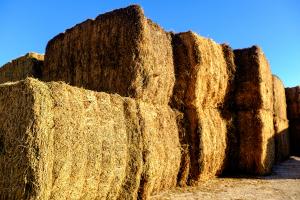Indiana Grazing Bites - January 2024
Victor Shelton is a retired Agronomist/Grazing Specialist with the Natural Resources Conservation Service (NRCS). He continues to write Grazing Bites in his spare time from his property in southwest Indiana.

Back when no-till farming was fairly new, one familiar catch phrase was “Farm Ugly.” Managing pastures in a more regenerative fashion sometimes appears a bit ugly too.
Right or wrong, I finally finished clipping the last few paddocks at the end of November. It wasn’t because they really needed to be clipped, but more because they were aesthetically more pleasing afterwards. It also puts most of them in the same starting phase for next less places for coyotes to hide.
I didn’t really procrastinate the task. With the dry conditions and slowed fall growth, I certainly didn’t want to remove or deter any grazable forage, so I waited until after the last grazing of those paddocks to clean it up by clipping them. Other pastures that were stockpiled didn’t need to be trimmed but a couple were done anyways because the wife insisted.
It has been a dry fall. I’ve had 4.95 inches of total rain since August 15 to the time I’m writing this article. That is about one third of the normal average. As one of my late uncles would say, “It will balance out eventually.” Unfortunately, it doesn’t always balance out in a timely manner.
The soil, as I’ve noted while hand digging a few post holes, is not particularly dry or at least not as dry as it was earlier this fall. That could be somewhat dependent on the site conditions where I was digging. Digging along side a fairly deep revine in October, the soil was very dry and almost not workable for any hand tools. As deep as the ditch bottom was, the drainage dried out the site excessively. If you went out into the pasture with good cover – yes, it was dry, but there was still some moisture even as dry as it was. That was due to good cover - we’ve noted that several times.
I think that we need to be as proactive as possible about managing moisture year around. I probably start sounding like a broken record – but you can’t under emphasize maintaining cover (year around), building organic matter, improving infiltration, and maintaining good quality forages (grasses, legumes, and forbs). We need to be prepared and proactive with such fecundity. There are no cheap alternatives.
Most producers will begin feeding hay this month if they haven’t already started. Hay supplies are low in many areas so getting the most out of what you have available becomes very important.
First of all, and something nobody ever likes to hear is that cows that are poor producers, didn’t get bred back in a timely manner or didn’t get bred back at all should grow some wheels. When winter feed is of a premium, slackers need to go.
You want to be as efficient as possible feeding hay. It might be easier to put out enough hay for several days or even a week, but doing so usually increases waste. Having a little competition between cows when feeding hay is actually a good thing. They are much more likely to clean it up and waste less when they think the other cows are after the same bite.
Unless you have certain nutritional needs for a particular bunch of livestock, it is generally better to feed poorer quality hay first. That poorer quality hay can also be supplemented as needed and hopefully you have tested some of the hay in advance in order to know its limitations. It’s much easier to move from poor quality to good quality than the reverse, especially when the supply is limited. Nobody wants to eat broccoli after having ice cream.
Hay fed in rings or feeding wagons slows down picking and sorting of the hay by the livestock and increases efficiency.
Hay fed on pasture while the soil is dry, in dry lots that have enough structure, or in winter feeding buildings all help to keep hay out of the mud with less waste.
Probably one of the most efficient ways to feed hay is sadly one of the least used today – small square bales. Small bales were allocated to the livestock on a daily and as needed basis and usually inside the barn in the manger. There was very little waste feeding hay this way. Labor is the most limiting factor for small bales today.
I admit that I’m not a fan of winter. However, winter does allow us to change our daily pace just a little bit with hopefully a little less work outside and a little bit more time inside with family or a good book. Before we know it, the gray, brown and white days of winter will start turning multiple shades of green again.
A good time to start sourcing clover seed for frost-seeding is in the near future!
May your roots grow deep, and your soil be rich – Happy New Year!
Remember, it’s not about maximizing a grazing event, but maximizing a grazing season! Keep on grazing!

